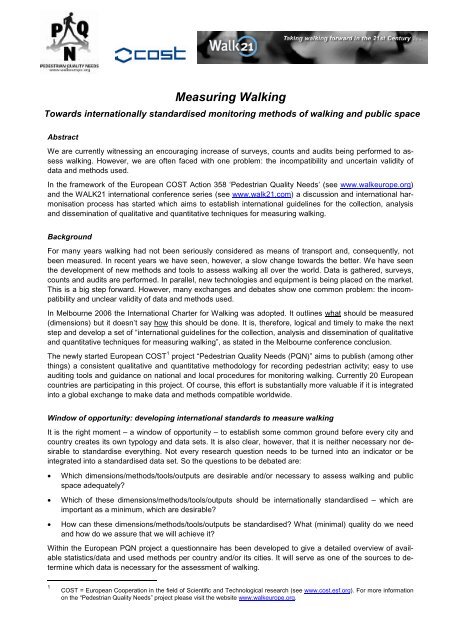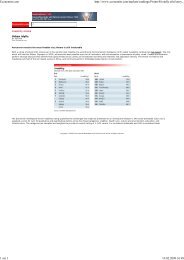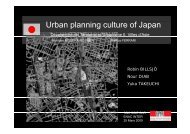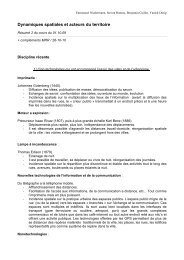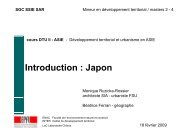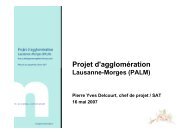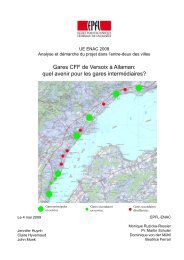Measuring Walking
Measuring Walking
Measuring Walking
- No tags were found...
You also want an ePaper? Increase the reach of your titles
YUMPU automatically turns print PDFs into web optimized ePapers that Google loves.
<strong>Measuring</strong> <strong>Walking</strong>Towards internationally standardised monitoring methods of walking and public spaceAbstractWe are currently witnessing an encouraging increase of surveys, counts and audits being performed to assesswalking. However, we are often faced with one problem: the incompatibility and uncertain validity ofdata and methods used.In the framework of the European COST Action 358 ‘Pedestrian Quality Needs’ (see www.walkeurope.org)and the WALK21 international conference series (see www.walk21.com) a discussion and international harmonisationprocess has started which aims to establish international guidelines for the collection, analysisand dissemination of qualitative and quantitative techniques for measuring walking.BackgroundFor many years walking had not been seriously considered as means of transport and, consequently, notbeen measured. In recent years we have seen, however, a slow change towards the better. We have seenthe development of new methods and tools to assess walking all over the world. Data is gathered, surveys,counts and audits are performed. In parallel, new technologies and equipment is being placed on the market.This is a big step forward. However, many exchanges and debates show one common problem: the incompatibilityand unclear validity of data and methods used.In Melbourne 2006 the International Charter for <strong>Walking</strong> was adopted. It outlines what should be measured(dimensions) but it doesn’t say how this should be done. It is, therefore, logical and timely to make the nextstep and develop a set of “international guidelines for the collection, analysis and dissemination of qualitativeand quantitative techniques for measuring walking”, as stated in the Melbourne conference conclusion.The newly started European COST 1 project “Pedestrian Quality Needs (PQN)” aims to publish (among otherthings) a consistent qualitative and quantitative methodology for recording pedestrian activity; easy to useauditing tools and guidance on national and local procedures for monitoring walking. Currently 20 Europeancountries are participating in this project. Of course, this effort is substantially more valuable if it is integratedinto a global exchange to make data and methods compatible worldwide.Window of opportunity: developing international standards to measure walkingIt is the right moment – a window of opportunity – to establish some common ground before every city andcountry creates its own typology and data sets. It is also clear, however, that it is neither necessary nor desirableto standardise everything. Not every research question needs to be turned into an indicator or beintegrated into a standardised data set. So the questions to be debated are:• Which dimensions/methods/tools/outputs are desirable and/or necessary to assess walking and publicspace adequately?• Which of these dimensions/methods/tools/outputs should be internationally standardised – which areimportant as a minimum, which are desirable?• How can these dimensions/methods/tools/outputs be standardised? What (minimal) quality do we needand how do we assure that we will achieve it?Within the European PQN project a questionnaire has been developed to give a detailed overview of availablestatistics/data and used methods per country and/or its cities. It will serve as one of the sources to determinewhich data is necessary for the assessment of walking.1COST = European Cooperation in the field of Scientific and Technological research (see www.cost.esf.org). For more informationon the “Pedestrian Quality Needs” project please visit the website www.walkeurope.org.
COST Action 358 PQN / WALK21 - 2 - <strong>Measuring</strong> <strong>Walking</strong>Objective / product: internationally agreed guidelinesThe objective is to create a handbook / reference book which contains a set of standardised methods andtechniques for measuring walking to achieve valid and reliable results. It will be supplemented with informationon available technologies (hardware and software) and will identify areas where more research isneeded.The first recommendations and guidelines shall be completed together with the PQN project in 2010 and bepresented at the planned joint PQN/WALK21 conference in the same year.It is suggested to handle the process of creating the guidelines similar to the one creating the InternationalCharter for <strong>Walking</strong>. This means: during the WALK21 conferences and PQN meetings draft papers/guidelineswill be presented and discussed. The debates and information collection in between conferences andPQN meetings will be handled via e-mail and through the PQN and WALK21 websites.Preliminary approach towards relevant dimensions<strong>Walking</strong> is a highly multi-dimensional activity. It is, therefore, necessary to measure it in many dimensions.After preliminary discussions the following dimensions are suggested:ABCDEFTransport and travel behaviour dataPedestrian counts (user counts), behaviour analysis (observations, interaction/conflict analysis) andpedestrian flows (models)Activity and time spent in public spaces (sojourn without mobility, stationary activities)Road danger/safety: traffic accidents with pedestrians (involving at least one vehicle) & single pedestrianaccidents (falling, stumbling etc.)Security: threats, attacks, harassmentsCompetences (disabilities), physical activity (walking), health and health outcomesG <strong>Walking</strong> environment, accessibility, public space quality and infrastructure provisions (“walkability”)HIJEcological footprint, land-usePerceptions, attitudes and images: personal satisfaction and subjective perception: “measuring the smiles”Investments, personnel and research: Data on institutional aspectsThese dimensions can each be divided in a number of sub-dimensions to adequately reflect the differentaspects (see e.g. the questionnaire developed within the European PQN project). They will also be linked tothe International Charter for <strong>Walking</strong>. In order to reflect the different needs and stages of development it issuggested to create three quality levels:• Quality Level 1 ‘basic’ or ‘minimal requirement’• Quality Level 2 ‘intermediate’ and• Quality Level 3 ‘elaborate’InvitationThis process is open to everyone interested: researchers, data users, persons responsible for measuringwalking in cities or municipalities, promoters of walking, providers of technical equipment etc. Please contactthe chair if you are interested in contributing.Chair and facilitatorDaniel Sauter, Urban Mobility Research, Zurich, Switzerland. daniel.sauter@urban-mobility.chZurich, 14 November 2007 / DSGuidelines to be developed in the framework of WALK21 and PQN / COST Action 358


